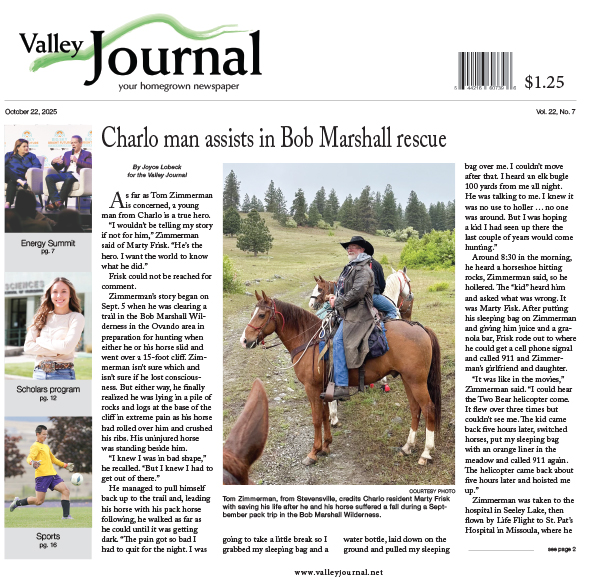St. Ignatius photographer exhibits art at Missoula Art Museum
Hey savvy news reader! Thanks for choosing local.
You are now reading
1 of 3 free articles.
News from the Missoula Art Museum
MISSOULA — This is the premier exhibition of Stephen Hunt’s photographs, “Kitawaahsinnoon, The Land that Feeds Us,” Aug. 9-Dec. 8, at the Lynda M. Frost Contemporary American Indian Art Gallery. Hunt studied photography with David J. Spear at Salish Kootenai College while pursuing his Bachelor of Science degree in social work. Hunt frames his photographs with a perspective of the land that connects to tribal stories or culturally significant events. Hunt, who is Blackfeet (Amskapii Pikaanii), Nez Perce (Nimipuu), Sioux (Sisseton), Pend d’Oreille (Qlispé), and Chippewa Cree (Ne Hiyawak), was raised on the Flathead Indian Reservation. His photographs span the Flathead Reservation, the Blackfeet Reservation, and the Blood Reserve, where his wife Chelsea is from. Hunt invites the viewer to experience his family’s travel between these places, poignant landscapes or events, and portraits of his daughters, Ksiskstaki-aakii and Soyiikayii-aakii as they grow up and learn about their cultural heritage.
The exhibition features two distinct bodies of work: images of the land and portraits. Taken as a whole, the photographs demonstrate the diversity of Hunt’s interests and reveal a consistency in Hunt’s photographic eye for active compositions. The forced perspectives and close framing create strong diagonal lines throughout the show. Hunt’s consistency allows him to move between subject matter and successfully unite the images. In “Land of the Goat,” the viewer is put in the foreground, making it an active rather than a passive experience. In “Chief Mountain,” again the vantage point places the viewer in the frame on the steep angle of the mountainside. Both of these images reference traditional stories or knowledge revealed by the viewer’s familiarity with Native culture or by the title. When Hunt turns his camera’s lens to capturing people, his main subject is his family. But again, Hunt invites the viewer into the scene —looking over a shoulder as his wife is pinned with an award in Niikahkomimm; up at his daughter in her regalia; at the kitchen counter as the family prepares meat for the winter. The portraits are glimpses of intimate family moments.
As part of his day job, Hunt works with websites and analytics, but he places his greatest efforts on his family, where he seeks to instill in his children the importance of land and culture. He regularly gives back to his community by volunteering and working with youth at cultural camps. Hunt also travels the powwow circuit singing with Black Otter, an original, Blackfoot-style and champion drum group. To prepare for this exhibition, Hunt reviewed over 16,000 images that he then narrowed down to 300, from which the final selection was made. Hunt states, “It is a small reflection of our, and my, connection to the land as first peoples.” MAM is committed to projects such as Hunt’s, to provide opportunities for the next generation of contemporary American Indian artists to exhibit new work.
Reflection on Stephen Hunt by David Spear
It might seem an unlikely place for a friendship to develop, a classroom at a tribal college, but the thing that sealed this harmony was the camera. So here comes this tall, quiet, thoughtful, and questioning person Stephen Hunt. From the moment of our first meeting, Stephen expressed concern about issues related to photography including culture, meaning, intention, and technique. As I got to know Stephen more, I learned that these components are in every part of his life. Stephen questions himself and his pictures when he is unsure they are complete. But he also celebrates them when he knows they work. He is an obsessive and prolific shooter. He has a connection to his family, his culture, his community, and the camera that is direct and unflinching.
After our first class, Stephen would periodically stop by my office on campus and we would speak about visual and conceptual topics, sometimes for hours. Then we’d meet again and again, continuing our discussion when we saw each other in the library or when we passed each other in aisles at the box store and during lunch at horse camp. The smile we shared when we saw each other was our handshake greeting. When Stephen enrolled in a second class, it became clear that he was on a path towards creating important work. I asked him one day what he thought about the idea of an exhibition outside the community. He wasn’t sure. I asked Brandon Reintjes what he thought of the idea of an exhibition of a young photographer from the Reservation. He thought for a moment and said, “It sounds curious.” The following afternoon the three of us made the trek to my campus office. We huddled around an aging computer, slowly going through Stephens’s work and listening to the meaning he so sensitively expressed about each image. Then came a commitment from MAM to show Stephen’s work, and a date was put in place for this exhibition. Behind the scenes we went through hundreds of images making painful decisions about what should stay. With nearly fifty prints laid out on the tables in that same basement office, some thirty pictures were selected and printed. Stephen was emotionally moved, seeing the reflection of his vision in these collected works. In the process not only has our friendship grown but our roles have evolved. These days Stephen teaches me; he has become my peer.
Stephen’s work is an important cultural signifier with each picture offering clues. In this exhibition he takes careful, sensitive steps to show and share his land, his family, and his history. This very close, inside perspective, brings to us - and to photography - aspects of his daily life. Stephen describes these works as his paintings. No outsider could do this, and no one who sees the work can think about such things in the same way as before. Thank you, Stephen.
















.jpg)
